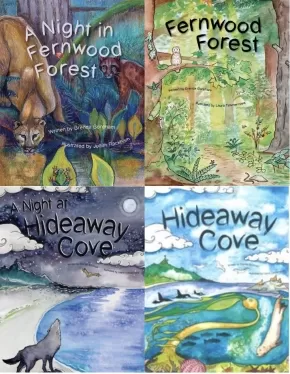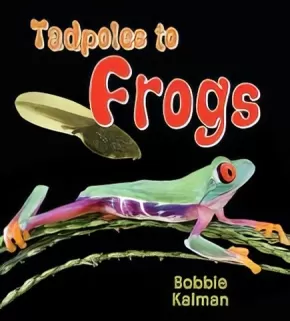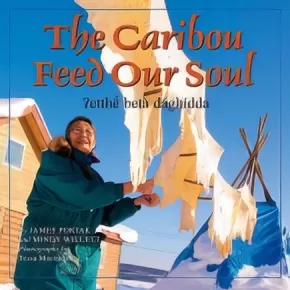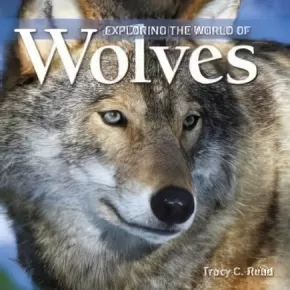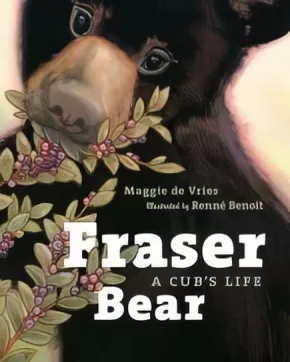Reading Connections - Non Fiction

Synopsis:
Come with us for a walk along a secluded forest trail on a quiet night in May. We catch glimpses of ten animals as they move about in their woodland home from dusk until dawn. A mother cougar and her cub, a colony of bats, and a family of shrews are among the nighttime creatures we encounter. Beautiful full-page illustrations also depict many plants that live in this ecosystem. Information at the back of the book provides facts about nurse logs and the Pacific Northwest temperate rainforest.
A Night in Fernwood Forest is part of the By Day and By Night Nature Series. Books in this series focus on a specific habitat and explore the many connections within a healthy ecosystem. Through lyrical stories, supportive illustrations, labelled diagrams, and nature notes, readers learn about living and non-living parts of the ecosystem.
Additionally, readers can:
- use a picture clue on each page to predict the animal featured on the next page
- count animals as their numbers increase in each illustration
- search for an animal that travels from page to page
- discover patterns in the text and structure of each book
- track the movement of the sun or moon across the sky
Reviews
"Brenda Boreham brings her teaching experience and love of nature to these books, filling them with opportunities for the discovery of interactions between plants and animals in healthy ecosystems…. This beautiful book will engage listeners and independent readers and support the science goals in elementary school classrooms." – Canadian Teacher Magazine, Winter 2024 issue
Readers with a sense of curiosity will find opportunities in these books to:
- use picture clues to predict the featured animal on the next page
- identify, count, and sequence numbers (1 owl, 2 deer, 3 squirrels, etc.)
- search for small creatures that travel from page to page
- discover patterns in the text and structure of the books
- track the movement of the sun, or moon, across the sky
Curriculum Links
Reading - Providing opportunities for guided practise in using reading strategies: visualizing, making connections, asking questions, transforming, and inferring.
Science - Supporting discussion and further exploration:
- characteristics of living things
- needs of living things
- connections between living and non-living things
- daily and seasonal changes
- animal growth and changes
- plant growth and changes
- weather
- habitats
- observable patterns in the sky
Numeracy - Counting and sequencing of numbers 1 to 10.
Social Responsibility - Initiating discussions about ways to take care of wilderness areas.
32 Pages | 8.5" x 11" | Hardcover | ISBN: 9781771746021

Synopsis:
This bundle includes all four titles in the By Day and By Night Nature Series:
- Hideaway Cove (hardcover)
- A Night at Hideaway Cove (paperback)
- Fernwood Forest (hardcover)
- A Night in Fernwood Forest (hardcover)
Each book in the By Day and By Night Nature Series focuses on a scene typical of a distinct west coast habitat, showing how living and non-living things are connected in a healthy ecosystem. As readers, we observe animals going about their daily activities: caring for their young, searching for food, and responding to the changes in light, temperature, and weather conditions throughout the day or night. The last four pages of each book provide facts about the highlighted animals and plants as well as features that are unique to their habitats. The final page suggests ways that young readers and their families can be respectful as they visit wilderness areas.
Readers with a sense of curiosity will find opportunities in these books to:
- use picture clues to predict the featured animal on the next page
- identify, count, and sequence numbers (1 owl, 2 deer, 3 squirrels, etc.)
- search for small creatures that travel from page to page
- discover patterns in the text and structure of the books
- track the movement of the sun, or moon, across the sky
Reading Level: Nonfiction text features such as headings, bold words, bullets, captions, and labelled diagrams make these books accessible to independent readers in grades 2 to 4. The books would also be great “read-alouds” for younger children.
Curriculum Links
Reading - Providing opportunities for guided practise in using reading strategies: visualizing, making connections, asking questions, transforming, and inferring.
Science - Supporting discussion and further exploration:
- characteristics of living things
- needs of living things
- connections between living and non-living things
- daily and seasonal changes
- animal growth and changes
- plant growth and changes
- weather
- habitats
- observable patterns in the sky
Numeracy - Counting and sequencing of numbers 1 to 10.
Social Responsibility - Initiating discussions about ways to take care of wilderness areas.
Lesson plans are available for each book and are free to download from each book's listing on our website!
Additional Information
Titles included are 32 pages, 8.5" x 11"
Please note: All books in this bundle are hardcovers, except for A Night at Hideaway Cove, which is a paperback as the hardcover edition is out of print.

Synopsis:
Join us on a bright, sunlit day in the middle of May as we wander the quiet trails of a secluded woodland. Here, we catch glimpses of the daily activities of many creatures—from a pair of black-tailed deer to a colony of carpenter ants—that make Fernwood Forest their home. We also learn about the three layers of the Pacific Northwest temperate rainforest and explore interesting facts about forest plants and animals.
Fernwood Forest is part of the By Day and By Night Nature Series. Books in this series focus on a specific habitat and explore the many connections within a healthy ecosystem. Through lyrical stories, supportive illustrations, labelled diagrams, and nature notes, readers learn about living and non-living parts of the ecosystem.
Additionally, readers can:
-
use a picture clue on each page to predict the animal featured on the next page
-
count animals as their numbers increase in each illustration
-
search for an animal that travels from page to page
-
discover patterns in the text and structure of each book
-
track the movement of the sun or moon across the sky
Readers with a sense of curiosity will find opportunities in these books to:
- use picture clues to predict the featured animal on the next page
- identify, count, and sequence numbers (1 owl, 2 deer, 3 squirrels, etc.)
- search for small creatures that travel from page to page
- discover patterns in the text and structure of the books
- track the movement of the sun, or moon, across the sky
Curriculum Links
Reading - Providing opportunities for guided practise in using reading strategies: visualizing, making connections, asking questions, transforming, and inferring.
Science - Supporting discussion and further exploration:
- characteristics of living things
- needs of living things
- connections between living and non-living things
- daily and seasonal changes
- animal growth and changes
- plant growth and changes
- weather
- habitats
- observable patterns in the sky
Numeracy - Counting and sequencing of numbers 1 to 10.
Social Responsibility - Initiating discussions about ways to take care of wilderness areas.
32 Pages | 8.5" x 11" | Hardcover | ISBN: 9781771745994
Synopsis:
A celebration of ten writers who have challenged stereotypes, told history from a perspective often silenced, and entertained millions of readers.
Included is author Louise Erdrich, whose novel Love Medicine was the first in an award-winning series about the lives of several generations of Ojibwa families. Sherman Alexie, author of the semi-autobiographical The Absolutely True Diary of a Part-Time Indian, went on to win the National Book Award. Tomson Highway broke new ground with his play The Rez Sisters. Joseph Boyden based his novel Three Day Road in part on his grandfather’s experience fighting in the First World War. N. Scott Momaday re-wrote the history of the American West with his book House Made of Dawn. Nicola Campbell drew on her family’s experience of residential schools to write the children’s books Shi-shi-etko and Shin-chi’s Canoe. Also included are Marilyn Dumont (A Really Good Brown Girl), Tim Tingle (Walking the Choctaw Road), Joseph Bruchac (Buffalo Song), and Maria Campbell (Half-breed).
The full list of writers profiled:
• Sherman Alexie (Spokane/Coeur d’Alene, Washington) - The Absolutely True Diary of a Part-Time Indian
• Louise Erdrich (Ojibwa, North Dakota) - Love Medicine (the Argus Series)
• Joseph Boyden (Cree/Métis, Ontario) - Three Day Road
• N. Scott Momaday (Kiowa/Cherokee, Oklahoma) - House Made of Dawn
• Marilyn Dumont (Cree/Métis, Alberta) - A Really Good Brown Girl
• Tomson Highway (Cree, Manitoba) - The Rez Sisters
• Joseph Bruchac (Abenaki, New York State) - Buffalo Song
• Maria Campbell (Métis, Saskatchewan) - Halfbreed
• Nicola Campbell (Interior Salish/Métis, Alberta) - Shin-chi’s Canoe
• Tim Tingle (Choctaw, Texas) - Walking the Choctaw Road
Educator & Series Information
This book is part of the First Nations Series for Young Readers. Each book is a collection of biographies of First Nations, Métis, and Inuit women and men who are leaders in their fields of work, in their art, and in their communities.
For ages 9-14.
Additional Information
128 pages | 6.00" x 9.00"
Synopsis:
Most babies are smaller versions of their parents, but some babies do not look anything like their adult counterparts. This book looks at the life cycle of pond frogs and tree frogs, with amazing photographs following their metamorphosis from tadpoles to adult amphibian. This book is so much more than just another life-cycle book, with easy-to-follow text describing frogs different habitats, how they find food, and how they protect themselves.
Educator & Series Information
Reading Level: Gr. 1-2
Interest Level: Gr. K-3
Guided Reading Level: J
This book is from the It's Fun to Learn About Baby Animals series. This beautiful series uses adorable pictures of baby animals to introduce basic curriculum concepts, such as animal classification, color and pattern, habitats, animals anatomy, sense, diet, family structures, the role of play, and life cycles. Children will love the pictures of the cute baby animals and will be thrilled to learn about how each animal lives.
Additional Information
24 pages | 8.20" x 9.30"
Synopsis:
Pete Enzoe is Chipewyan Dene from Lutsel K’e, Northwest Territories, on the East Arm of Great Slave Lake. He is a hunter, fisher, and trapper. He sees his role in life as protector of the caribou and spends much of his time “reading” the land as he travels his peoples’ traditional areas. Pete also helps scientists to monitor the herd’s health and migration. In The Caribou Feed Our Soul, the sixth book in The Land is Our Storybook series, Pete takes readers on a respectful caribou harvest. Along the way, he shares creation stories about how his people are descendants of the caribou. He also describes the spiritual areas his community is trying to protect, including Thaidene Nene, which means “land of our ancestors.” Pete’s stories help the reader to understand the rich history of the Chipewyan Dene and their relationship with the caribou today.
Educator & Series Information
This is the sixth book in the "The Land Is Our Storybook" series, which considers the diverse lands and cultures of Canada's Northwest Territories. Told in a uniquely diverse range of northern voices, with a child-centred approach, books in the series highlight each official Aboriginal language group in the NWT, revealing a richly textured picture of life in the North-on the trapline, around the campfire, in communities, at school, and within the outdoor school that is the land itself. The series celebrates the seasons, ages, genders, traditional activities, and communities of the NWT.
The stories are illustrated by the striking images of acclaimed northern photographer, Tessa Macintosh and depict the similarities in lifestyle between children of the North and South, as well as the marked cultural differences, and highlight the special relationship these First Nations people have with the land and how they are adapting to rapid change while remaining connected to the land. Images of the landscape and animals within it, of trapping, hunting, fishing, and bannock baking sit alongside pictures of children at school, swimming at recreation centres, and reading in libraries. Here is modern northern culture painted beautifully: a complex mix of the new and the old.
These wonderful books, written with a variety of provincial and territorial curricula in mind, are specially designed for the classroom and include special features such as glossaries relating details on animals biology and cultural definitions, regional and language maps. The text of the stories also have sidebars such as Our Stories, which contain the stories of the people and language group featured, and Our Words, which highlight words in the featured language that are important to the story.
Recommended Grade Level: 2-7
Additional Information
|
Synopsis:
Coyotes are wily, secretive and extremely adaptive -- what young reader wouldn't be fascinated?
Familiar to kids and adults alike through its many appearances in folk and popular culture, the multicolored coyote has the gray wolf to thank for its survival. As humans eliminated wolf populations across the continent over the last century, the coyote easily filled the gap. Today it is the most successful and most numerous large predator in North America. It makes its homes not only in the wild but increasingly in suburbs and even urban centers -- the coyote is wary of humans but is quite willing to enter the human world in pursuit of food.
The coyote has a curious blend of characteristics that it shares with its dog-family relatives, the wolf and the red fox. Like the red fox, it has graceful, catlike movements. Like the wolf, it can hunt in packs but may also hunt on its own or with a partner.
Exploring the World of Coyotes explains how the wily coyote achieved such great success, from its elaborate communication skills, mate selection and family life to its adaptive life skills and physical characteristics.
Educator & Series Information
This book is part of the "Exploring the World of..." series, a nature series produced especially for young readers who are eager to learn more about the wild animals they find especially appealing. The books are packed with facts and offer outstanding value. Clear text in large type and vivid photographs with explanatory captions describe the animals' physical attributes, and storylike narratives about their daily life -- where they live, what they eat, how they hunt, how they communicate, how they raise their young -- present a complete picture of each animal.
Additional Information
24 pages | 8.00" x 8.00"
Synopsis:
High flight with North America''s mighty eagles.
Only two kinds of eagles live in North America, the bald eagle and the golden eagle. These majestic birds belong to the same family and share many physical traits and behaviors, but there are also important differences between them.
In this fully illustrated introduction, young readers will discover why the bald eagle lives along the coastlines of oceans, lakes and rivers while the golden eagle prefers mountainous regions, prairies and plains. They''ll learn about the impressive nest-building skills of these two raptors and their courtship displays, mating patterns and fierce hunting styles.
Full-color photographs provide close-ups and action shots of these aerial performers, while the engaging text, sidebars and captions offer insights into the life history of two of the world''s most powerful winged predators.
Series Information
This book is part of the "Exploring the World of..." series, a nature series produced especially for young readers who are eager to learn more about the wild animals they find especially appealing. The books are packed with facts and offer outstanding value. Clear text in large type and vivid photographs with explanatory captions describe the animals' physical attributes, and storylike narratives about their daily life -- where they live, what they eat, how they hunt, how they communicate, how they raise their young -- present a complete picture of each animal.
Additional Information
24 pages | 8.00" x 8.00"
Synopsis:
The wild, wary gray wolf.
The largest wild member of the dog family, the gray wolf stalks much larger mammals, such as the elk, caribou and moose. How does it succeed? Built to run, the long-legged wolf on the hunt uses its powerful sight, hearing, smell and physical strength. But, like the domestic dog, the wolf is a social animal: it lives in a pack.
In this fully illustrated introduction, young readers will learn how group living makes sense for the wolf, allowing it to form strong bonds and share tasks like rearing its young, finding food and communicating over long distances. They''ll also find out how habitat destruction, poisoning campaigns and hunting have reduced gray wolf populations in much of North America.
Full-color photographs provide close-ups and action shots, while the engaging text, sidebars and captions tell the life history of an animal that researchers agree has one of nature''s most engaging personalities.
Educator & Series Information
This book is part of the "Exploring the World of..." series, a nature series produced especially for young readers who are eager to learn more about the wild animals they find especially appealing. The books are packed with facts and offer outstanding value. Clear text in large type and vivid photographs with explanatory captions describe the animals' physical attributes, and storylike narratives about their daily life -- where they live, what they eat, how they hunt, how they communicate, how they raise their young -- present a complete picture of each animal.
Additional Information
24 pages | 8.00" x 8.00"
Synopsis:
Fraser Bear follows the first two years in a black bear cub's life in the Pacific Northwest. Fraser's days are filled with adventure, danger, and delight -- and the endless quest for food. He learns the fun of sliding in the snow, the sounds of owls and coyotes, how to find and fill his belly with berries, and how to scurry up a tree and hang on for his life. Most important, he tries to learn the skill of salmon catching from his mother. Eventually, Fraser must leave the protection of his mother and sister and journey on by himself. This exciting story is illuminated by beautiful illustrations of Fraser and his adventures, uniting the cycles of bear and fish, whose lives are so importantly intertwined. A map of the area, glossary, and further information about bears and salmon complete this delightful nature story for young readers.
Additional Information
48 pages | 8.00" x 10.00"
Synopsis:
Dazzling inventions from the far north.
Today's Arctic communities have all the comforts of modern living. Yet the Inuit survived in this harsh landscape for hundreds of years with nothing but the land and their own ingenuity. Join authors Alootook Ipellie and David MacDonald as they explore the amazing innovations of traditional Inuit and how their ideas continue to echo around the world.
Some inventions are still familiar to us: the one-person watercraft known as a kayak retains its Inuit name. Other innovations have been replaced by modern technology: slitted snow goggles protected Inuit eyes long before sunglasses arrived on the scene. And other ideas were surprisingly inspired: using human-shaped stone stacks (lnunnguat) to trick and trap caribou.
Many more Inuit innovations are explored here, including:
- Dog sleds
- Kids' stuff
- Shelter
- Food preservation
- Clothing
- Medicine.
In all, more than 40 Inuit items and ideas are showcased through dramatic photos and captivating language. From how these objects were made, to their impact on contemporary culture, The Inuit Thought of It is a remarkable catalog of Inuit invention.
Educator & Series Information
Recommended Ages: 10-12.
B.C. Science Supplementary Resource: Gr.3- Physical Science
B.C. Science Supplementary Resource Gr.4- Life Science
This book is a part of the We Thought of It series, a series which takes readers on a fascinating journey across the world's second largest continent to discover how aspects of its culture have spread around the globe.
Additional Information
32 pages | 8.50" x 11.00"



